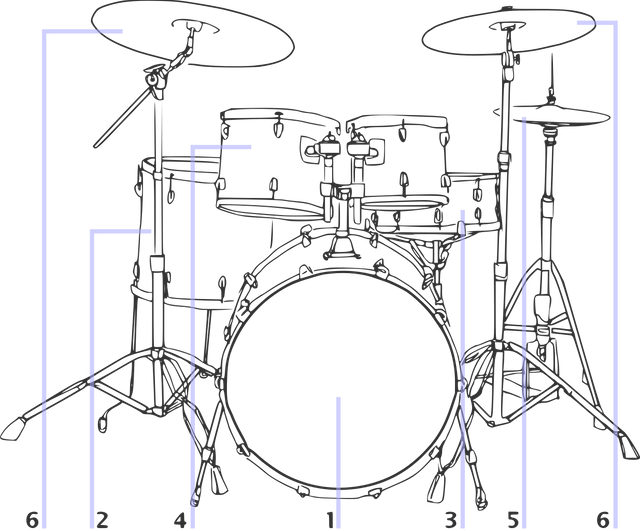Hey there Steemit community,
Welcome to Part 1 of my tutorial series on playing drums. This series will be targeted at absolute beginners, those who may have just bought their first drum kit, or have always been interested in the basics of playing drums. This series will aim to teach you the fundamentals of playing drums with a special focus on reading drum sheet music.
Please feel free to add your suggestions and comments below to help me improve the quality of the tutorials.
The Drum Kit
The first step in learning to play the drums is understanding each part of the kit itself. A drum kit is really a collection of many different instruments, which are combined in a special arrangement to allow the drummer to produce intricate, percussive sounds. The parts in a drum kit generally include pedals, drums, cymbals and stands.
Although there is no one standard drum kit setup, to get started we will look at the most commonly used, 5 piece arrangement. The image below is taken from Wikipedia and depicts a typical drum kit setup.

1. Bass Drum- Normally played with your right foot, the bass drum sound is made by depressing a pedal attached to a mallet. Pushing down with your foot causes the mallet head to strike the bass drum with a strong force, producing a loud, booming sound. The bass drum is the beating heart of any band, its loud low sound acts as a metronome which helps the other instruments stay in time.
2. Floor Tom- The most commonly used tom, it is the second lowest pitch drum in the kit. Many drummers will use the floor tom as the only additional drum to the bass and snare, for an easy to transport drum kit. This drum is used in fills and many well known drum beats.
3. Snare Drum- The snare drum is the most unique drum in the kit, and is so essential to any drummer that it will have its own dedicated tutorial later down the line. There are many sounds a drummer can make from the snare drum, these are generally high pitched and staccato. The snare itself is a group of curled wires that form a strap, tightly held against the bottom skin of the drum. This rattles when it is hit to give it that distinctive sound.
4. Hanging Toms - Toms give a drummer expression in his playing. These can be used as accents in beats or in drum fills to emphasis key moments in a musical piece. These have a higher pitch than the bass and floor tom and come in many different sizes and tones.
5. The Hi-Hat- This is the most important cymbal in the drum kit. The hi-hat is made by combing two separate cymbals on the one stand. The bottom one faces up and remains stationary on the cymbal stand. The second is attached to a pedal via a long shaft which the drummer moves up and down with his foot. The hi-hat can be played with the sticks, the foot via the pedal or a combination of both to produce many different sounds.
6 (Right). Crash cymbal- The crash cymbal sounds exactly as its name implies. It is a loud sharp penetrating sound that gives a drummer an exclamation mark in a piece of music. It is often used at the end of a fill or to cap of a crescendo in a piece of music.
6 (Left). Ride Cymbal- The ride is a large cymbal which normally sits above the floor tom. It is usually played in a similar fashion to the hi-hat, in a rhythmic pattern. The ride has a long ringing sustain when hit by a stick and is most frequently found in swing and jazz music, but is commonly used in all music genres.
There are many other drums and cymbals that many drummers consider integral to a normal drum kit, such as splash and china cymbals, woodblocks, cowbells and other percussion instruments.
This concludes the basic over view of the key components of the drum kit. To get you excited about learning the drums, here is a video of one of my favorite drummers Thomas Pridgen:
fantastic!

ive always wanted to learn
Downvoting a post can decrease pending rewards and make it less visible. Common reasons:
Submit
I will hopefully have the next installment up in the next day or so :)
Downvoting a post can decrease pending rewards and make it less visible. Common reasons:
Submit
Don't give a shit, have some money.
Downvoting a post can decrease pending rewards and make it less visible. Common reasons:
Submit
Cheers!
Downvoting a post can decrease pending rewards and make it less visible. Common reasons:
Submit
Thank you for taking the time to teach us how to build a proper drum kit.
Downvoting a post can decrease pending rewards and make it less visible. Common reasons:
Submit
My pleasure, the next session will have more on positioning the kit and setting up to play. I will try to add one on tuning later on.
Downvoting a post can decrease pending rewards and make it less visible. Common reasons:
Submit
I can play guitar (mainly chords) and I've played keyboards in bands, but I've always wanted to play drums. I especially love funk drumming. Thanks for the post !
Downvoting a post can decrease pending rewards and make it less visible. Common reasons:
Submit
Very nice for the first steps ....
Downvoting a post can decrease pending rewards and make it less visible. Common reasons:
Submit
Congratulations @djma! You received a personal award!
You can view your badges on your Steem Board and compare to others on the Steem Ranking
Vote for @Steemitboard as a witness to get one more award and increased upvotes!
Downvoting a post can decrease pending rewards and make it less visible. Common reasons:
Submit